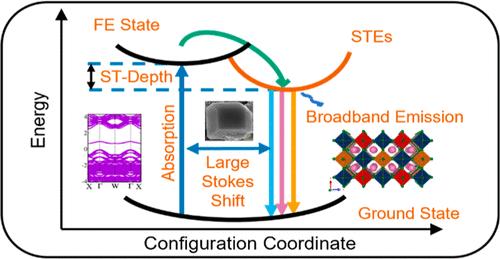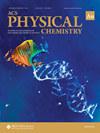无铅 Cs2AgBiCl6 双包晶:光电应用中自捕获的实验和理论启示
IF 3.7
Q2 CHEMISTRY, PHYSICAL
引用次数: 0
摘要
无铅双包晶石(DPs)将成为铅-卤化物包晶石的可行且环保安全的替代品,如果其光电特性得到极大改善,则会表现出稳定性和无毒性。实验证明,掺杂是增强 DP 材料光电特性并同时降低缺陷态密度的有力工具。从根本上了解 DP 的光学特性,尤其是自俘获激子(STEs)动力学,在一系列光电应用中起着至关重要的作用。我们的研究通过了解 Cs2AgBiCl6 DPs 的 STEs 动态,探讨了铁掺杂如何影响其结构和光学特性,而这正是目前文献中所缺乏的。该研究采用实验-计算相结合的方法来研究纯的和掺杂的 Cs2AgBiCl6(Fe-Cs2AgBiCl6)包晶石的光电特性。X 射线衍射和拉曼光谱证实了 Fe3+ 离子的成功掺入。此外,Fe-Cs2AgBiCl6 DPs 在 400 纳米以下至 700 纳米的范围内表现出强烈的吸收,这表明亚带隙态转变源于表面缺陷。光致发光(PL)分析表明,PL 强度显著增强,这归因于辐射重组率增加和 STE 密度提高。利用时间分辨光致发光(TRPL)方法研究了辐射动力学和平均寿命;此外,随温度变化的光致发光测量为活化能和激子-声子耦合强度提供了宝贵的见解。我们的研究结果不仅加深了我们对与 STE 相关的电荷载流子动力学的理解,而且为设计一些用于光电子学和光催化的前景广阔的过氧化物材料铺平了道路。本文章由计算机程序翻译,如有差异,请以英文原文为准。

Lead-Free Cs2AgBiCl6 Double Perovskite: Experimental and Theoretical Insights into the Self-Trapping for Optoelectronic Applications
Lead-free double perovskites (DPs) will emerge as viable and environmentally safe substitutes for Pb-halide perovskites, demonstrating stability and nontoxicity if their optoelectronic property is greatly improved. Doping has been experimentally validated as a powerful tool for enhancing optoelectronic properties and concurrently reducing the defect state density in DP materials. Fundamental understanding of the optical properties of DPs, particularly the self-trapped exciton (STEs) dynamics, plays a critical role in a range of optoelectronic applications. Our study investigates how Fe doping influences the structural and optical properties of Cs2AgBiCl6 DPs by understanding their STEs dynamics, which is currently lacking in the literature. A combined experimental–computational approach is employed to investigate the optoelectronic properties of pure and doped Cs2AgBiCl6 (Fe–Cs2AgBiCl6) perovskites. Successful incorporation of Fe3+ ions is confirmed by X-ray diffraction and Raman spectroscopy. Moreover, the Fe–Cs2AgBiCl6 DPs exhibit strong absorption from below 400 nm up to 700 nm, indicating sub-band gap state transitions originating from surface defects. Photoluminescence (PL) analysis demonstrates a significant enhancement in the PL intensity, attributed to an increased radiative recombination rate and higher STE density. The radiative kinetics and average lifetime are investigated by the time-resolved PL (TRPL) method; in addition, temperature-dependent PL measurements provide valuable insights into activation energy and exciton–phonon coupling strength. Our findings will not only deepen our understanding of charge carrier dynamics associated with STEs but also pave the way for the design of some promising perovskite materials for use in optoelectronics and photocatalysis.
求助全文
通过发布文献求助,成功后即可免费获取论文全文。
去求助
来源期刊
CiteScore
3.70
自引率
0.00%
发文量
0
期刊介绍:
ACS Physical Chemistry Au is an open access journal which publishes original fundamental and applied research on all aspects of physical chemistry. The journal publishes new and original experimental computational and theoretical research of interest to physical chemists biophysical chemists chemical physicists physicists material scientists and engineers. An essential criterion for acceptance is that the manuscript provides new physical insight or develops new tools and methods of general interest. Some major topical areas include:Molecules Clusters and Aerosols; Biophysics Biomaterials Liquids and Soft Matter; Energy Materials and Catalysis

 求助内容:
求助内容: 应助结果提醒方式:
应助结果提醒方式:


